Ducks are a beloved bird in North America, often seen waddling around wetlands and lakes. From the majestic Mallard to the curious Wood Duck, these feathered friends have inspired many with their beauty and grace.
In this article, we’ll explore 30 of the most common ducks found in North America, fun facts about each species, and where they can be seen. Let’s learn more about our feathered friends.
Article Highlights
- There are two types of ducks: dabbling ducks, which feed close to the surface of the water by tipping up and upending; and diving ducks, which dive down to the bottom of lakes or rivers for their sustenance.
- Ducks play an important role in their environment as they support healthy wetlands by consuming aquatic vegetation and insects while also helping disperse seeds across regions during migration seasons.
- Each species has distinct features such as plumage color and size that help identify them easily from other birds. They also have unique behaviors such as courtship displays or migration patterns during different seasons throughout their range across the continent.
30 Ducks in North America
Dabbling Ducks vs diving ducks
Dabbling ducks are a group of waterfowl that use their specialized bills to scour the surface and depths for sustenance. These aquatic birds can be seen in both fresh and saltwater habitats, often gliding gracefully over shallow pools or bobbing along a river or creek. Their short but broad beaks allow them to feed by submerging their heads into the water with ease.
Diving ducks are a type of waterfowl that feed by dabbling or diving underwater. Also known as sea ducks, they typically have large, heavy bodies and long, strong legs. These birds dive down to the bottom of lakes and rivers, scooping up aquatic plants, crustaceans, and small fish with their bills.
1. Mallard duck
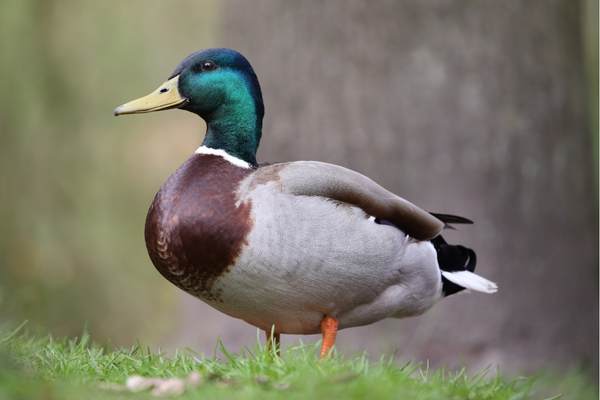
The mallard duck is a common sight in many parts of North America. Its distinctive green head, brown body, and white stripes on the wings make it easy to identify.
The mallard is a dabbling duck, meaning they feed close to the surface of the water, typically by tipping up and upending. They feed on aquatic vegetation, insects, and mollusks, as well as grains, fruits, and seeds from the land.
2. Wood duck
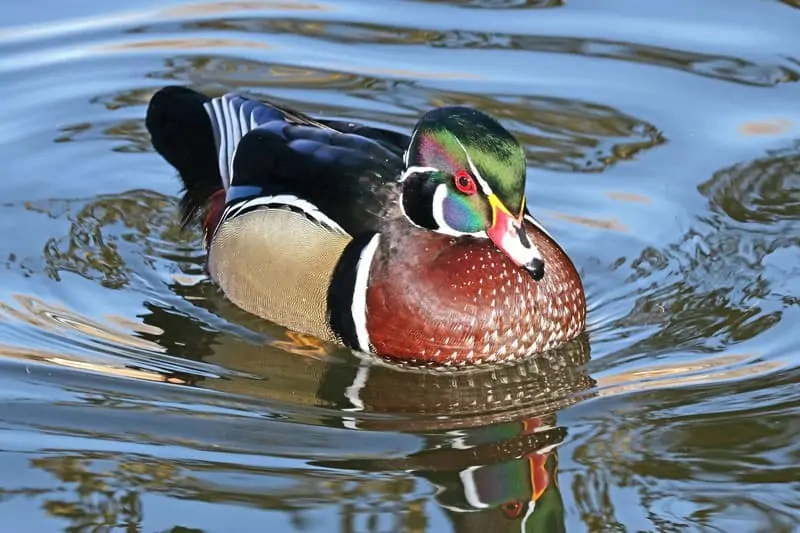
A common sight in many areas of North America, the wood duck boasts some eye-catching plumage with reddish brown and white markings, as well as a purple-green head and brilliant yellow eyes. Additionally, this species can be seen easily near marshy regions due to its habit of nesting in tree cavities.
Wood ducks are known to be relatively bold and unafraid of humans, allowing for easy viewing from a distance. This has made them popular among birdwatchers and photographers alike.
3. Harlequin duck
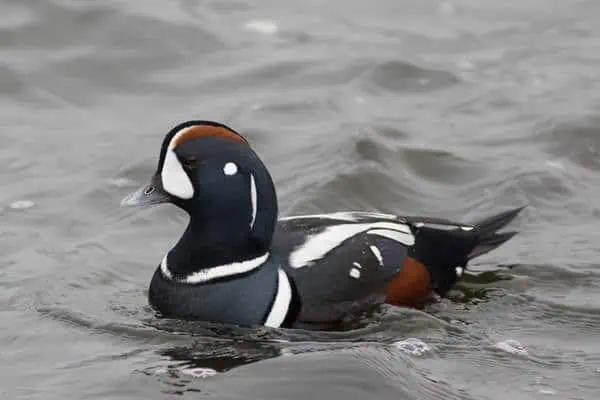
Standing between 16-19 inches tall and weighing up to 2.2 pounds, the harlequin duck is a small sea duck native to North American coasts. Unlike its cousin, the Hooded Merganser, it does not build nesting cavities in trees, rather preferring aquatic habitats like rivers or streams when the breeding season arrives.
The male has a distinctive pattern of black, white, and gray that gives it the appearance of being ‘dressed up’ in costume, hence its name. The female is more muted in coloration, with a light brown head and back, white breasts and grayish-brown wings, and flanks.
4. American wigeon
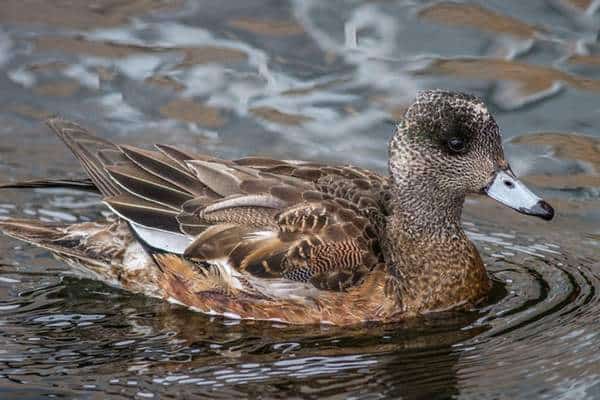
The American wigeon is a widespread duck found in much of the United States and Canada. It can be identified by its distinctive white forehead, green head, and brown body with white patches on the wings. The male has an iridescent purple patch on the top of his head and a bright yellow bill.
Females are similar in color but have a duller bill. The American wigeon is commonly found in shallow wetlands and marshes.
It feeds mainly on aquatic plants, but it also eats insects, crustaceans, and mollusks. During winter months, the wigeon will migrate south to warmer regions of the US and Mexico.
5. Northern pintail
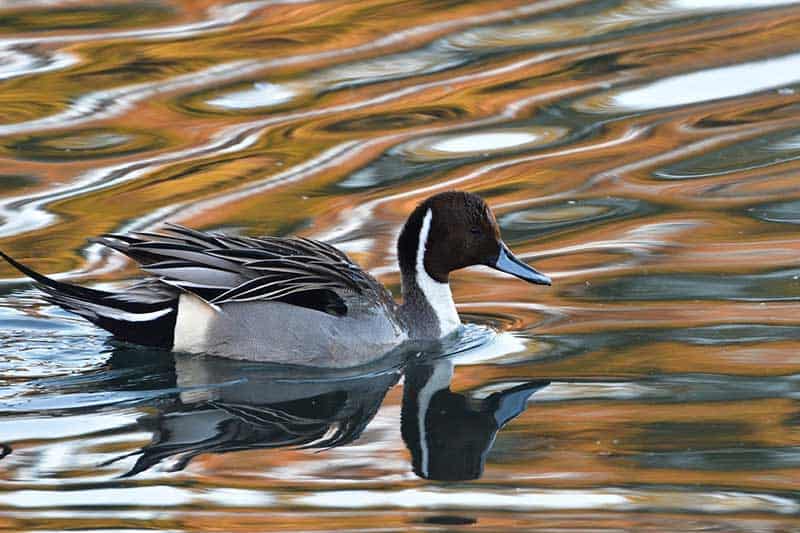
The Northern pintail, a distinctive species of duck featuring an elongated neck and slender body structure similar to that of the mallard, is indigenous to North America. It makes its home in marshes, ponds, lakeside areas, and coastal stretches across the continent. Striking with its gray, white-tipped feathers, and elongated tail streamers, the male is easily recognizable.
Meanwhile, the female has a unique plumage featuring brown, black, and white stripes on her wings. These elegant birds favor shallow wetland habitats that have abundant vegetation for foraging, as well as unfettered access to open waters where they can feed comfortably.
6. Gadwall duck
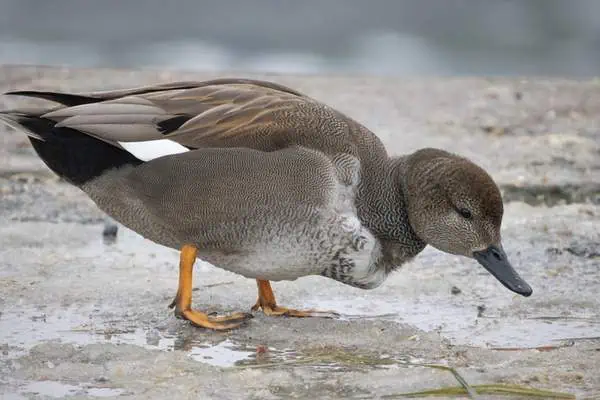
An extremely common species of dabbling duck, the gadwall duck can be found in the United States, Canada, and Mexico. Typically, they tend to occupy shallow wetlands such as ponds, lakes, marshes, or even flooded fields for their habitat needs.
Gadwall ducks feed by submerging their heads and tipping forward in the water to find aquatic vegetation. Additionally, they consume a wide range of insects, mollusks, crustaceans, and even tinier fish species.
7. Common goldeneye
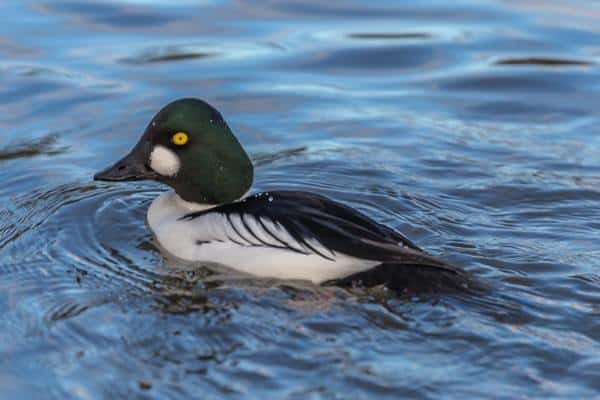
The common goldeneye is a captivating species of duck that can be seen in North America. Its tan-brown flanks, black back and wings, white head and neck with golden eyes, and blue-gray bill with a dark tip make it an impressive sight to behold.
This medium-sized diving duck flourishes during the winter months on lakes and rivers before retreating northward in the summertime to its boreal forest habitats located throughout Canada, Alaska, as well as certain parts of northern American states.
This species nourishes itself with underwater vegetation, eggs from fish, mollusks, bugs, crustaceans, and young fishes. It emits a high-pitched whistle that carries over extended distances – making it one of the most noticeable sounds in its habitat.
8. Green-winged teal
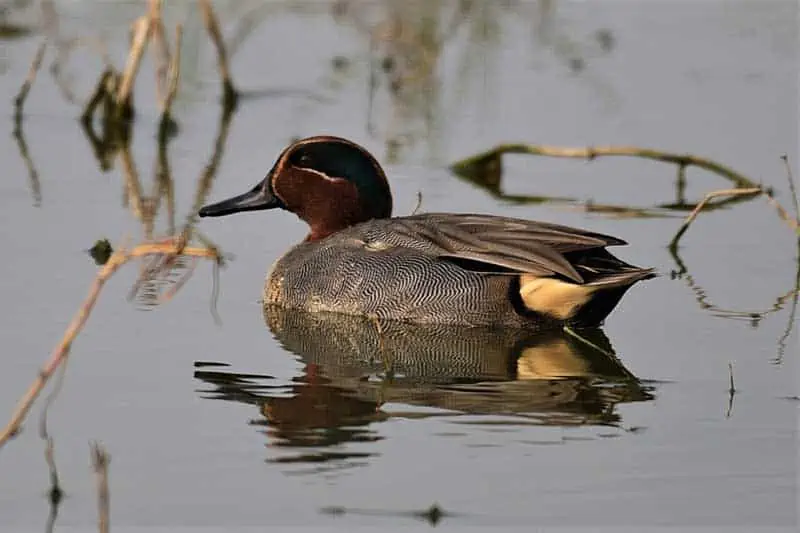
The exquisite green-winged teal, the smallest member of all dabbling ducks, sports an impressive emerald patch on its wings. This species has adapted superbly to various human activities across North America, making it a widespread duck throughout the continent.
The ideal environment for this bird is shallow bodies of water like marshes and wetlands, as well as lush meadows which they retreat to during winter months while migrating in colossal flocks.
9. Northern shoveler
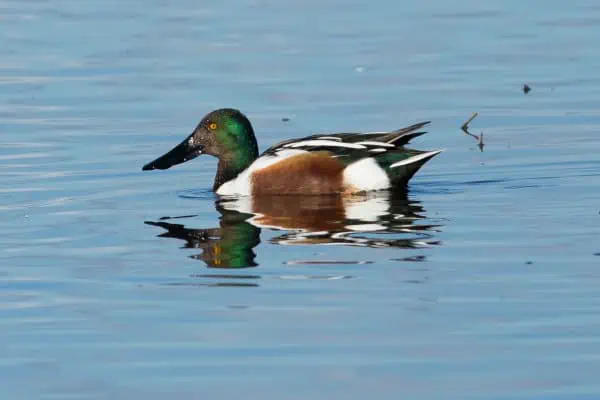
This dabbling duck is native to North America and easily identifiable by its bright yellow eyes and large spoon-billed bill. It boasts stunning male plumage featuring bright green heads with chestnut sides, contrasted against the dull mottled brown female feathers.
Both males and females boast white breasts over pale gray bellies for an overall elegant appearance. This medium-sized bird has a wingspan ranging from 26 to 32 inches in length and spends much of its time feeding near wetlands, lakes, marshes, ponds, or shallow rivers.
10. Ring-necked duck
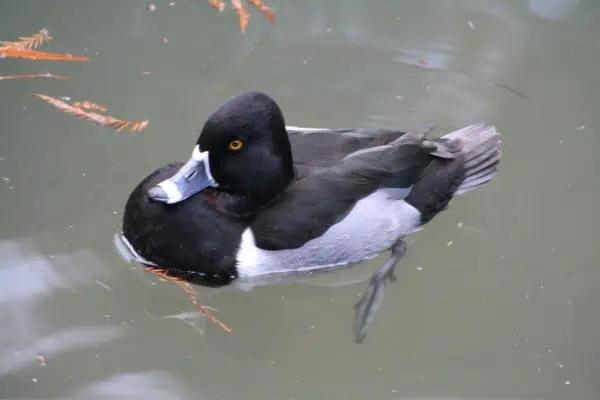
An extraordinary species of diving duck, the ring-necked can be found across North America. They have captivating black and white heads, coupled with a pale gray chest, brown back and belly, plus a vibrant blue bill featuring an orange ring near the tip – all of which make them stand out from other birds.
Males possess dazzling green and purple iridescent feathers on their heads and necks, adding a splash of color to the tranquil freshwater marshes, ponds, lakes, and rivers across North America.
When winter comes around, these ring-necked ducks migrate southwards from Alaska or Canada’s northernmost regions; come summer they lay claim to the boreal forests in Canada as their breeding ground.
11. Cinnamon teal
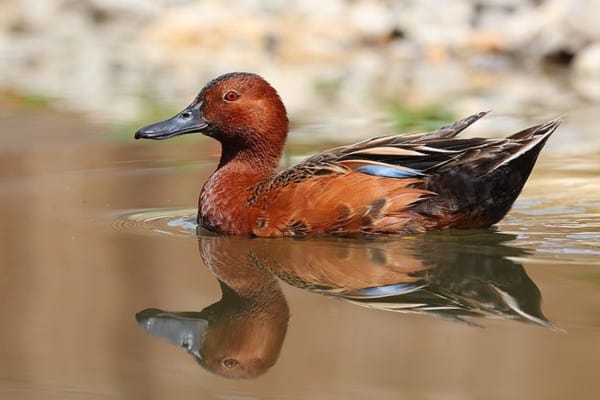
An American dabbling duck species, the cinnamon teal inhabits the western side of North America. It stands out with its gorgeous cinnamon-red head and upper body combined with grayish-blue wings. Males sport a bright red beak while females have a more muted orange-brown one.
Found most often in shallow marshes, ponds, lakes, and slow-moving rivers, these ducks are omnivores happily snacking on plants, algae, and insects alike. The cinnamon teal is a popular target for waterfowl hunters due to its large size and attractive plumage.
It is a migratory species, with individuals breeding in the western United States in the late spring/summer before migrating south during the winter. The cinnamon teal plays an important role in ecosystems, providing food for larger predators and helping to disperse seeds.
12. King eider
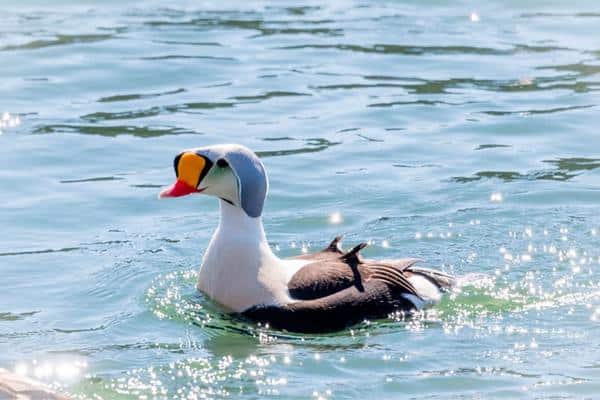
The resplendent king eider is a species of duck that adorns the waterways and wetlands of North America, particularly in the eastern and central United States. These avian delights prefer lush wetland environments with an abundance of emergent vegetation as well as open water to forage upon.
Their diet encompasses aquatic insects alongside small fish, mollusks, crustaceans, plants, and seeds. Not only do they have a diverse appetite, but their plumage is equally vivid; boasting greenish-black heads & necks complemented by fiery orange bills.
13. Bufflehead
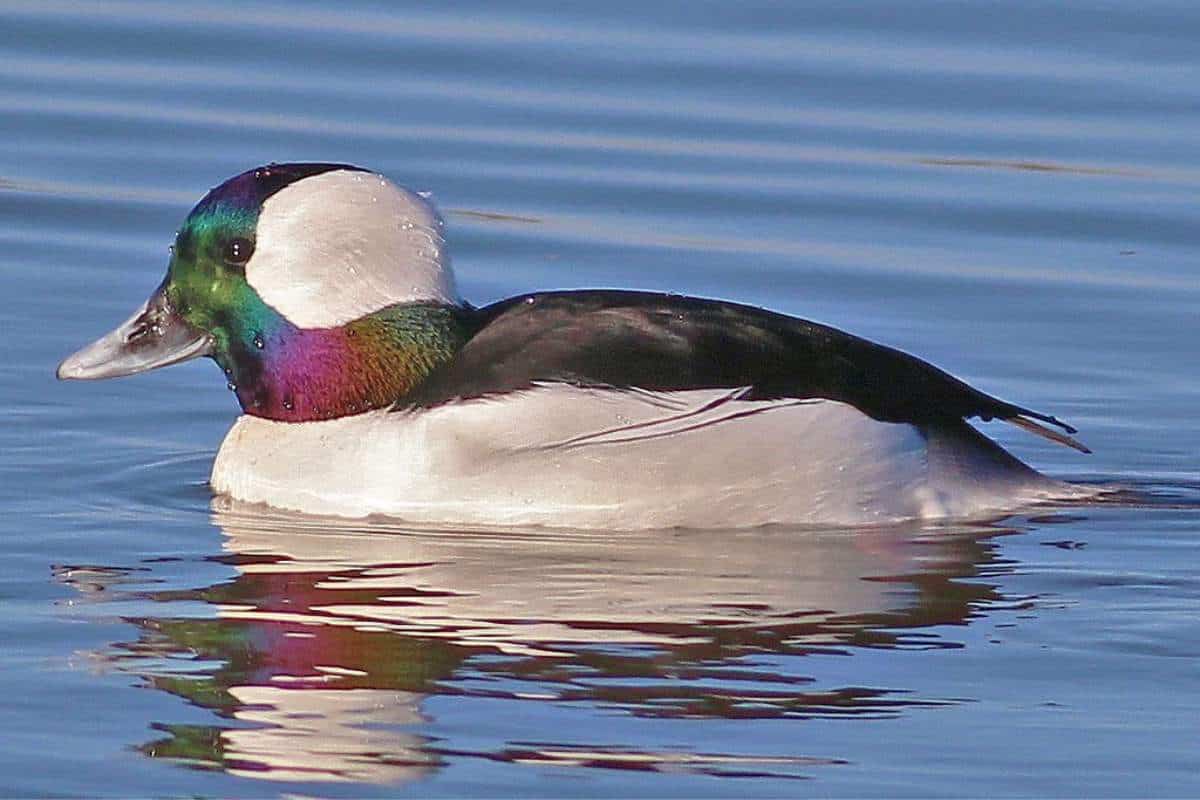
The distinctive bufflehead is a beloved bird native to North America, with its large head and white feathers decorated with black around the eyes and neck.
It prefers shallow wetlands near coastal bodies of water in Alaska, Canada, and the Northern United States for its habitat. This small duck dives confidently into watery depths to hunt for food such as aquatic insects, fish eggs, or small invertebrates using its uniquely shaped bill.
14. Mottled duck
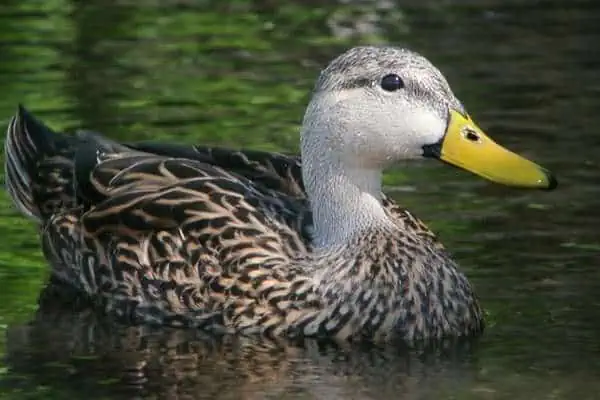
The captivating mottled duck is a species of dabbling duck with an illustrious range from the southeastern United States to Mexico.
Sporting exquisite plumage with males having dark gray-brown feathers and females exhibiting mottled browns and tans, this species excels in beauty as much as serving an ecological purpose: controlling insect populations by consuming them.
With long bills, yellow legs, and strikingly vibrant colors on their wings and body, they are certainly worth admiring for their beauty as well as their role in creating healthier wetlands across North America.
15. American black duck
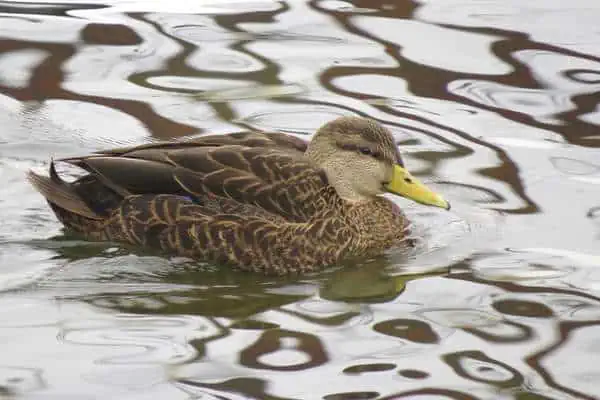
The enigmatic American black duck is a species of dabbling duck found across various regions in North America, from Canada to the Atlantic coast. This species stands out as it has dark feathers that range from almost black to dark brown and can often be distinguished by its yellow bill and legs.
This bird serves an important role in its environment, as it supports the health of wetlands by consuming a wide range of aquatic vegetation, insects, and other invertebrates.
It is also known to be fairly shy and secretive, often nesting in thickly wooded areas near bodies of water. As a result, they can be difficult to spot without proper knowledge or expertise.
16. Lesser scaup
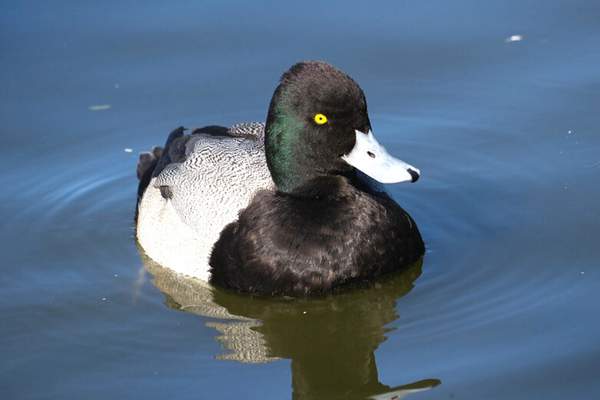
With an astonishing population of 12 million birds during the 2018-2019 season, it’s no wonder why the lesser scaup is one of North America’s most widely distributed dabbling ducks. It can be effortlessly identified by its attractive plumage pattern – a dark head and neck, white sides, topped with a purplish-blue bill.
The male has black feathers on its wings and back, with an iridescent purple sheen in the sunlight, while the females have a mottled brown and gray back. The lesser scaup feeds mainly on small plant matter.
17. Hooded merganser
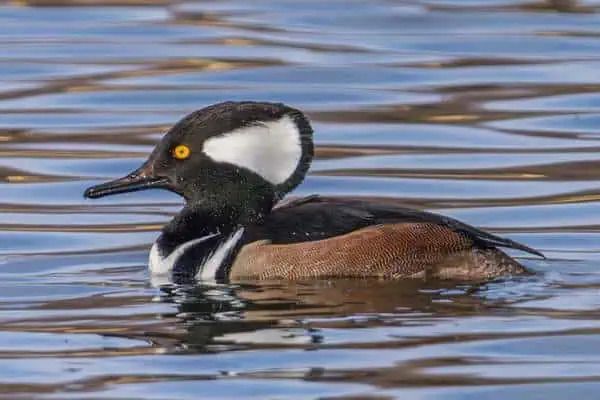
The majestic hooded merganser is a one-of-a-kind duck species found in North America. Not only do these birds inhabit the wooded wetlands of the northern United States and southern Canada, but they also migrate to as far south as Mexico during wintertime.
Its stunning plumage sets it apart from other ducks: adult males boast white heads with black bibs on brown backs, while females flaunt their mottled grayish-brown bodies with a luxurious white crest atop their heads.
18. Canvasback
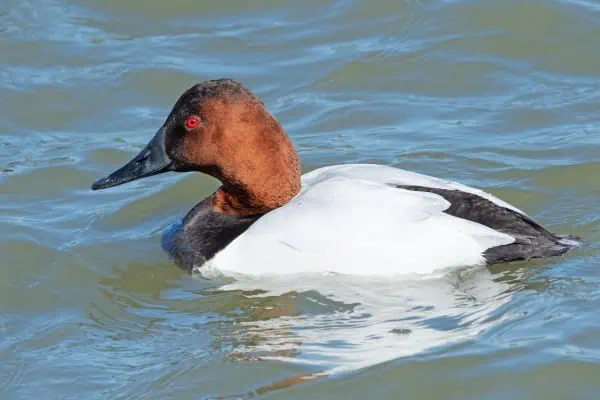
The imposing canvasback is a species of dabbling duck native to North America. It sports a striking black-and-white plumage pattern and can be easily recognized by its long, sloping head, robust body, red eyes, and large bill. This species primarily feeds on aquatic vegetation such as tubers and underwater grasses.
During the breeding season, males of this species are known for their incredible courtship displays. Paired couples will engage in synchronized swimming and diving rituals as a demonstration of their devotion to each other. This duck is also an important keystone species in North America’s wetlands, helping to regulate aquatic vegetation growth by consuming it.
19. Surf scoter
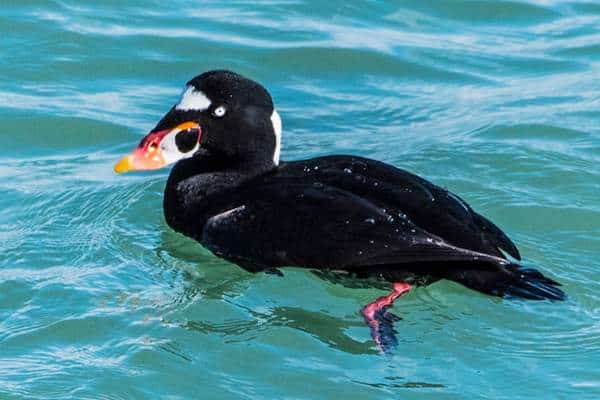
A native species of sea duck that can be witnessed throughout the coasts and internal waters of North America, the surf scoter boasts striking black plumage with white patches around its face, wings, and tail feathers. The male possesses an orange bill while the female’s bill appears mainly black in hue.
Surf scoters primarily reside in shallow waters like bays and estuaries, nestled among rocky or sandy beaches. These birds feed by scavenging the shoreline for an array of food items such as mollusks, crustaceans, worms, small fish, and aquatic vegetation.
20. Steller’s eider
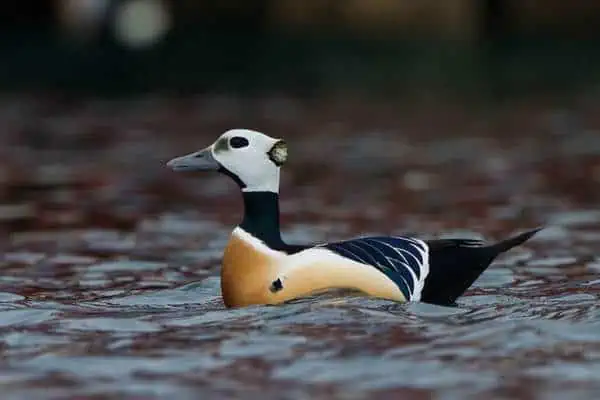
The Steller’s eider is a species of sea duck found in North America. It breeds in the Arctic and subarctic regions of Alaska and Northern Canada, and winters along the coasts of the Bering Sea, Aleutian Islands, and the Gulf of Alaska. This duck has contrasting features of black and white plumage, a long neck, and a large orange bill.
21. Fulvous whistling duck
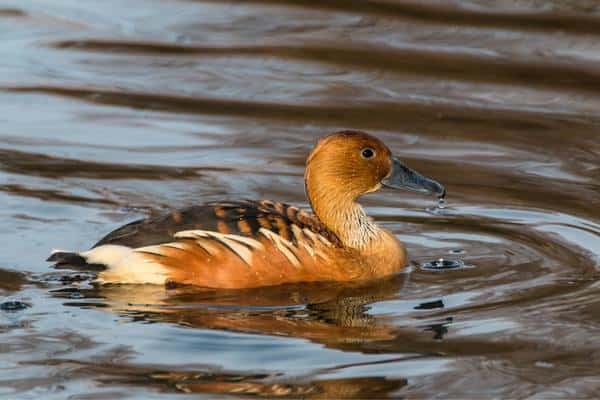
The fulvous whistling duck is known for its unique high-pitched call, which sounds like a whistle, giving these waterfowl their name. Adult ducks have brownish-red bodies and wings, with lighter-colored feathers around their neck and head, and a long, pointed bill. Young whistling ducks are similarly colored, but simply more spotted.
In the Southern United States, this duck is most commonly seen in wetlands or even flooded agricultural fields looking for food and nesting. Preferring to rest in trees, they are also commonly called the fulvous tree duck.
22. Barrow’s goldeneye
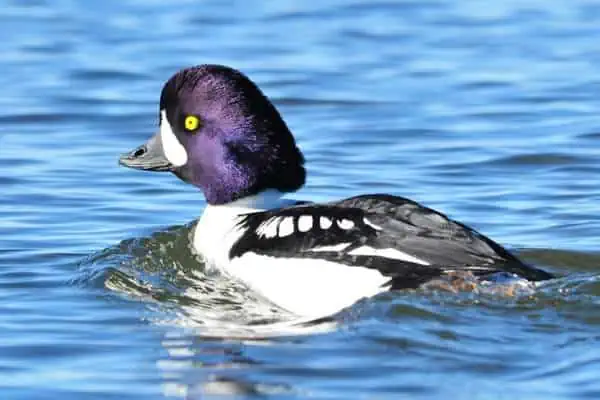
A sea duck that breeds in Canada, this medium-sized duck has a blackish-brown head, white neck and breast, and brown wings with bright yellow eyes. The male Barrow’s Goldeneye has a stunning black and white patterned head that can be easily seen from a distance.
This expert forager dives into the cold waters of its northern range to feed on fish, mollusks, crustaceans, aquatic insects, and plants. It prefers shallow water habitats such as streams, lakes, and marshes.
The Barrow’s Goldeneye is a migratory bird, with most of the population spending winters along the Pacific Coast of North America and in Alaska. During migration, flocks can often be seen flying over large bodies of water in V-shaped formations.
23. Black scoter
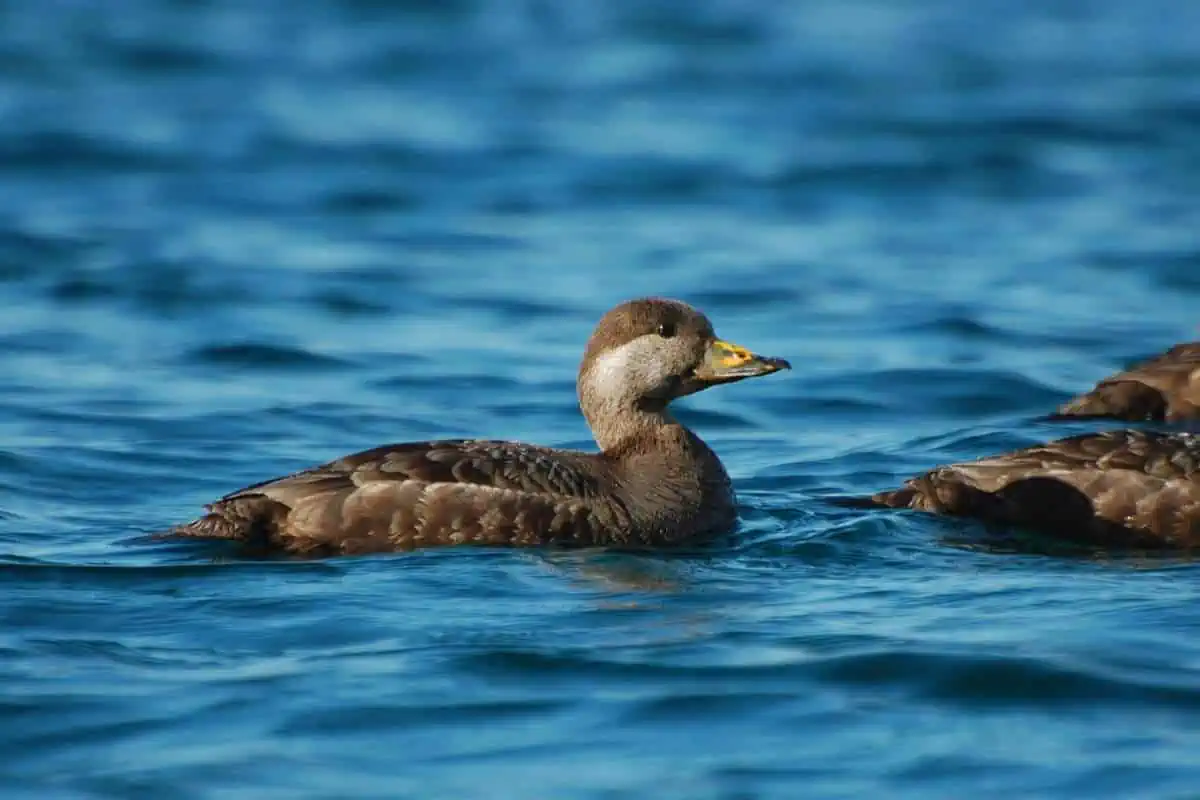
This diving duck can be found along the coasts of North America, easily identifiable by the black head, neck, and chest. The back is dark brown and the wings are light gray with a striking white spot on its forehead and a yellow bill.
Black scoters can be seen in small flocks or alone in shallow coastal waters, estuaries, and bays. They feed on crustaceans, mollusks, fish, plant material, and some insects.
During the summer months, Black Scoters breed in the boreal forests of Alaska, Canada, and northern parts of the United States. During winter months, they migrate south to the coasts of California, New England, and down to Mexico.
24. Common eider
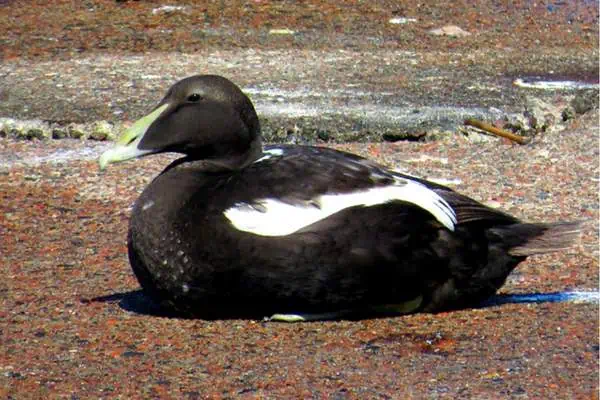
Different from the King eider in that it does not display the spectacular head plumage of the King eider, the Common eider is a large, stocky sea duck that prefers the icy waters of Canada.
A medium-sized sea duck, with males being significantly larger than females, the male Common eider has a black head and neck, a white patch near the base of its bill, and a distinctive white-and-black barred back. The female is somewhat more muted in its plumage with dark brown coloring and a white chin and throat.
25. Common merganser
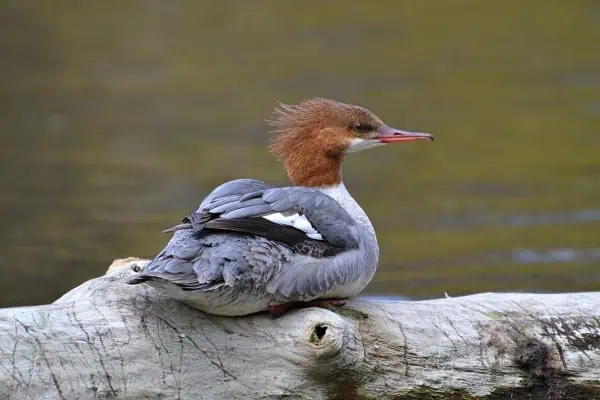
A member of the waterfowl family Anatidae, this large fish-eating duck breeds in northern areas of North America. The male Common Merganser has an iridescent green crown, chestnut sides, and a white chest, while females are markedly less identifiable with brown plumage.
These ducks thrive in a wide range of habitats, including lakes, rivers, streams, and ponds. They prefer slow-moving water with plenty of vegetation and open spaces in which to dive for food. The Common Merganser is an opportunistic feeder, eating anything from fish to aquatic plants.
26. Greater scaup
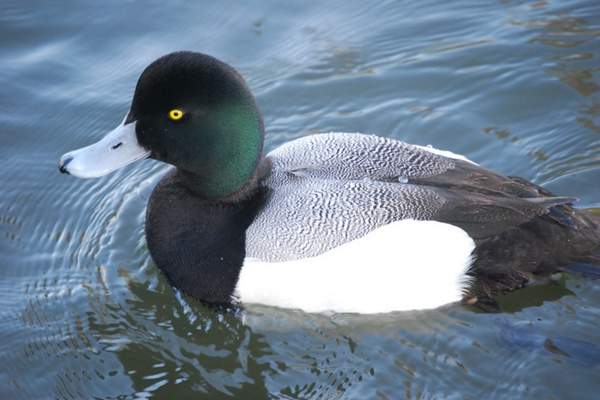
The Greater scaup is a medium-sized diving duck native to North America. It is one of the most abundant and widespread ducks on the continent and is a popular game bird.
With a blackish-brown body and a purplish-blue head and neck, males are slightly larger than females and can be identified by their bright white wing patches. Its bill is black with a yellow spot near the tip.
27. Long-tailed duck

A species of sea duck found on the east and west coasts of North America, this duck is known for its long tail feathers, which can measure up to 8 inches in length. The long-tailed duck is a medium-sized waterfowl, with a wingspan of 20 to 24 inches.
These birds migrate south for the winter and can be found in coastal bays and estuaries throughout their range. They feed primarily on small crustaceans, aquatic insects, and mollusks.
28. Red-breasted merganser
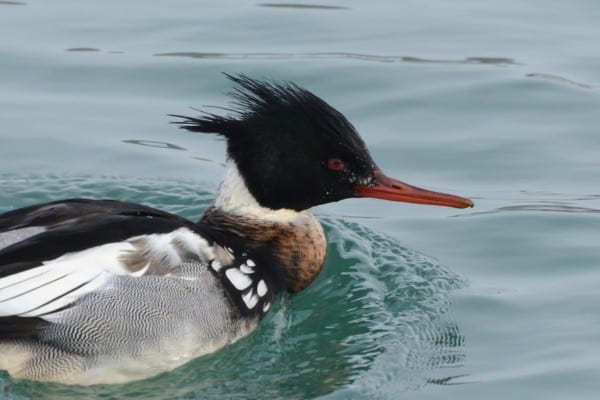
This large diving duck is a common winter visitor to the Great Lakes region. It is easily identified by its long, slender body and bright red head and bill. The Red-breasted Merganser is a migratory species that breeds in the northern reaches of Canada and Alaska and can be found wintering along both coasts of the United States.
An excellent swimmer, this diving duck uses its long, thin bill to hunt for small fish and crustaceans in the water. During the breeding season, these birds form large colonies that nest on the ground near water or in cavities of trees and shrubs. Females lay up to 11 eggs, which are incubated for about 28 days.
29. Spectacled eider
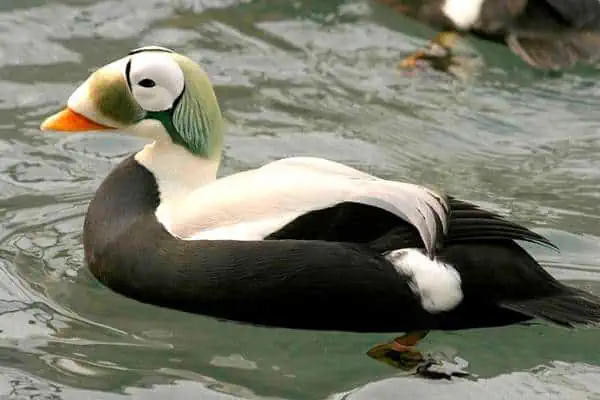
This eider is native to the coastal regions of Alaska. It is the smallest of the three eider species found in North America, measuring about 18 inches in length and weighing about two pounds.
It has a white head, neck, and breast with black speckles, or “spectacles,” which give the species its name. The back and wings are dark brownish-gray.
30. White-winged scoter
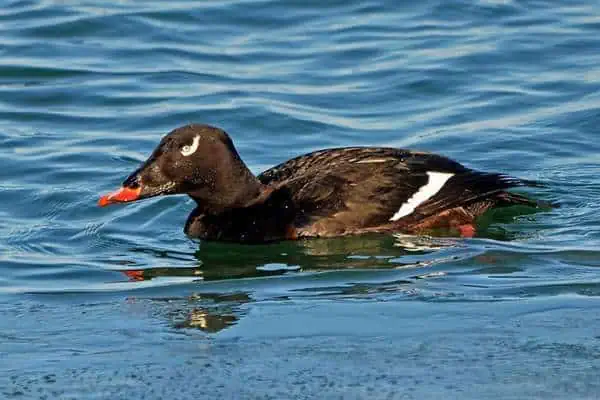
This scoter is a medium-sized sea duck that is found in the northern parts of the continent, from Canada to Alaska. The male white-winged scoter is black with a white wing patch, while the female has a brownish body with a white eye ring.
It dives for crustaceans, mollusks, aquatic insects, fish, and plants. Nesting in large colonies near rivers and lakes during the breeding season, the white-winged scoter makes its way down toward the upper part of the United States during the winter.





